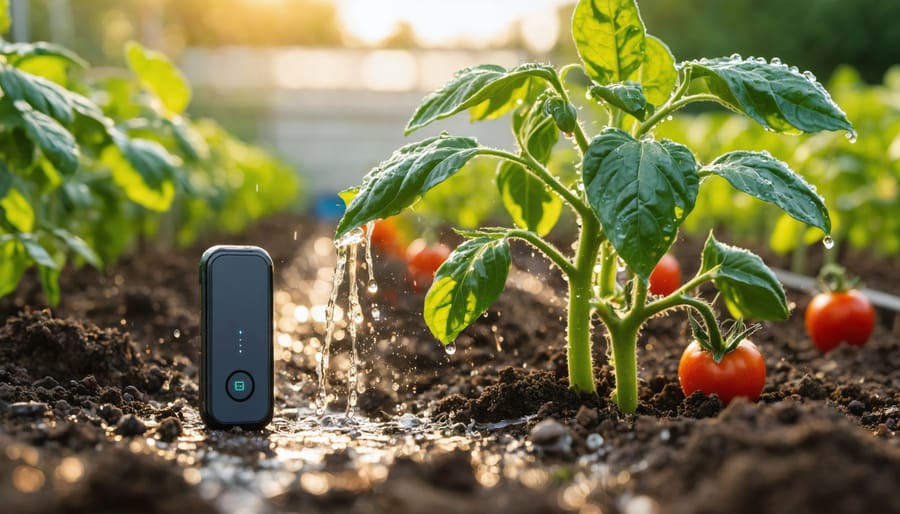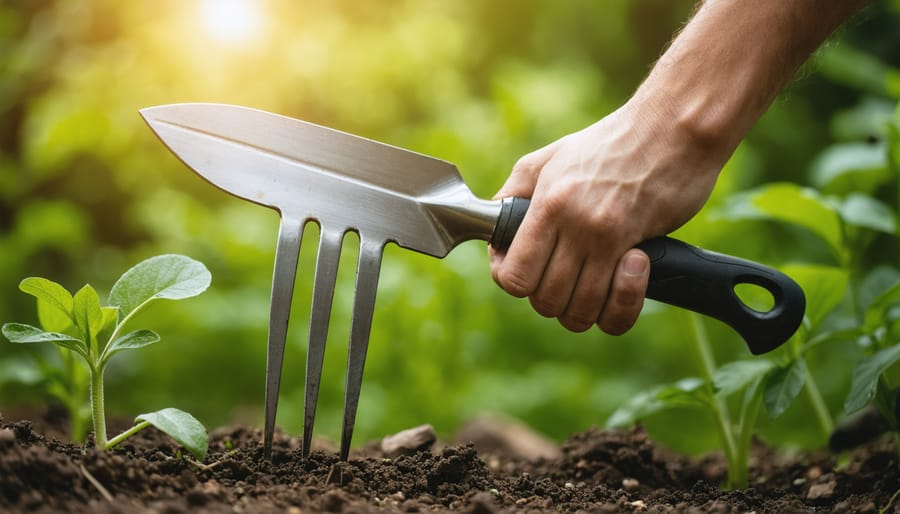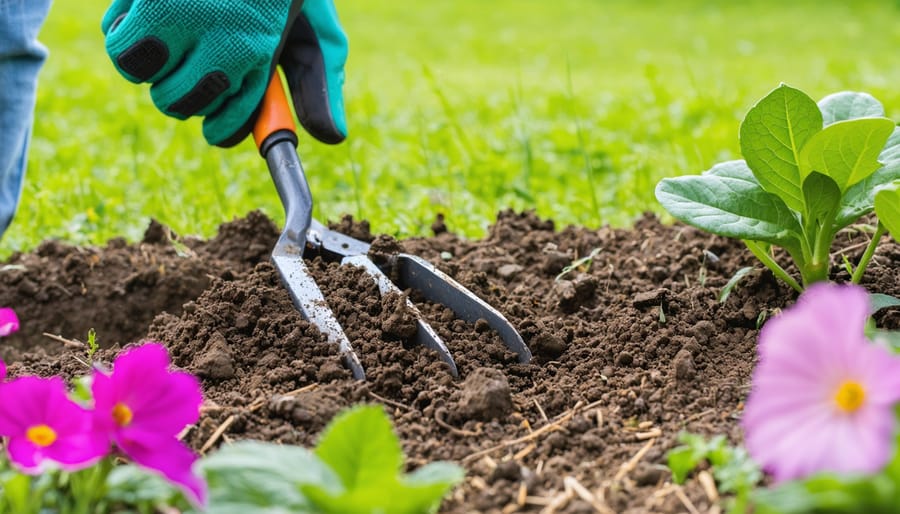Transform your outdoor space with the right landscaping tools – from essential power equipment to precision hand implements that make every garden task more efficient and enjoyable. Whether you’re creating a new garden bed, maintaining pristine lawns, or tackling major landscape renovations, understanding your equipment options unlocks professional-quality results. Modern landscaping tools combine ergonomic design with innovative technology, helping both weekend gardeners and seasoned professionals work smarter, not harder.
Today’s landscaping arsenal includes everything from battery-powered tools that rival traditional gas equipment to specialized implements designed for specific garden tasks. As sustainable practices become increasingly important, many of these tools now feature eco-friendly designs and materials that reduce environmental impact while maximizing performance. This comprehensive guide explores the must-have equipment for every landscaping project, proper usage techniques, and maintenance tips to extend the life of your investment.
Let’s dive into the essential tools that will elevate your landscaping game, starting with power equipment that handles the heavy lifting, moving through versatile hand tools for detailed work, and finishing with specialized gear for specific landscaping challenges.
Essential Power Tools for Modern Landscaping
Battery-Powered Revolution
The landscape of gardening tools has undergone a remarkable transformation with the emergence of battery-powered equipment. These cordless innovations are changing the way we maintain our outdoor spaces, offering a perfect blend of power and convenience without the hassles of traditional gas-powered tools.
Modern lithium-ion batteries now deliver impressive runtime and consistent power, making battery-operated trimmers, mowers, and leaf blowers viable alternatives to their gas counterparts. One of the biggest advantages is the instant start – no more wrestling with pull cords or mixing fuel ratios. Just press a button, and you’re ready to go.
The benefits extend beyond convenience. Battery-powered tools run significantly quieter than gas engines, meaning you can work earlier in the morning or later in the evening without disturbing neighbors. They’re also notably lighter, reducing fatigue during extended use, and require minimal maintenance compared to gas equipment.
Environmental consciousness is another compelling reason to consider the switch. Battery-powered tools produce zero direct emissions and don’t require oil or gas, making them an eco-friendly choice for the environmentally mindful gardener. Many manufacturers now offer interchangeable battery systems, allowing you to use the same battery across multiple tools, which adds both convenience and cost-effectiveness.
While initial costs might be higher, the long-term savings on fuel and maintenance often offset the investment. Today’s battery-powered tools can handle most residential landscaping needs effectively, though professional landscapers working long hours might still prefer gas-powered equipment for extended use. For the average homeowner, however, the combination of convenience, reduced noise, and environmental benefits makes battery-powered tools an increasingly attractive option.
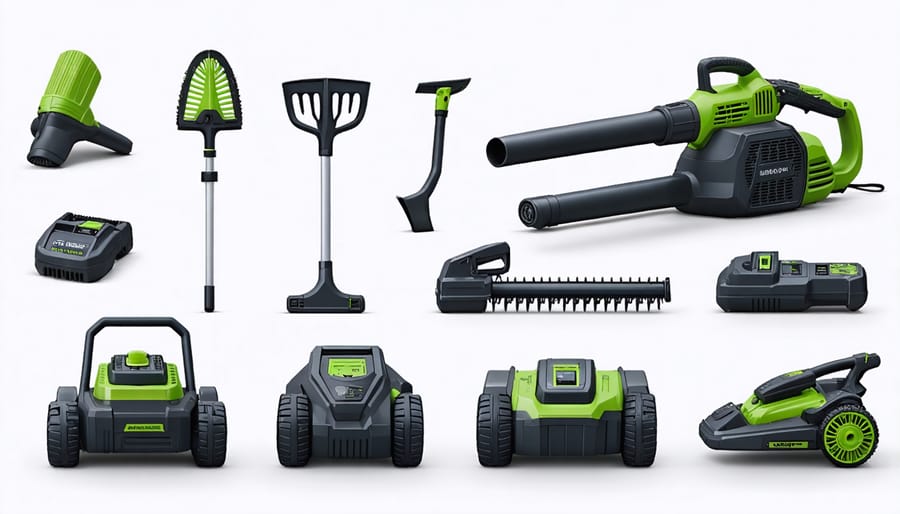
Smart Technology Integration
Modern landscaping has embraced technological innovation, bringing a new wave of smart gardening tools that make outdoor maintenance more efficient and enjoyable. These intelligent devices combine traditional functionality with digital features, helping gardeners work smarter, not harder.
Smart irrigation controllers lead the pack, using weather data and soil moisture sensors to optimize watering schedules. Many can be controlled through smartphone apps, allowing you to adjust settings remotely and receive notifications about your garden’s watering needs. Some models even integrate with local weather forecasts to automatically skip watering when rain is expected.
Robotic lawn mowers have revolutionized lawn care, operating autonomously to maintain perfect grass height. These quiet workers can navigate complex garden layouts, avoid obstacles, and return to their charging stations when needed. Many gardeners find they save countless hours while maintaining consistently manicured lawns.
Smart soil sensors have become invaluable for precise plant care, measuring moisture levels, nutrient content, and pH balance. These devices sync with mobile apps to provide real-time data and care recommendations specific to your plants. Some even create detailed reports of your soil’s health over time, helping you make informed decisions about fertilization and watering.
LED growing lights with smart controls allow for year-round gardening, automatically adjusting light intensity and duration based on plant needs. Many systems can be programmed to simulate natural daylight cycles and can be monitored through mobile devices.
While these high-tech tools might seem complex, most are designed with user-friendly interfaces and clear instructions, making them accessible even for those who aren’t particularly tech-savvy. The initial investment often pays off through reduced water usage, better plant health, and significant time savings.
Hand Tools Getting Smarter
Ergonomic Innovations
Modern ergonomic gardening tools have revolutionized the way we approach landscaping, making tasks easier and more comfortable for gardeners of all ages and abilities. These thoughtfully designed tools help prevent strain and fatigue while allowing you to work longer with less physical stress.
Extended-reach handles are game-changers for tasks that typically require bending or stretching. Tools like telescoping pruners and adjustable rakes let you maintain perfect posture while working. Cushioned, non-slip grips have replaced traditional wooden handles, reducing hand fatigue and providing better control in wet conditions.
Lightweight materials like carbon fiber and aluminum alloys have made tools significantly lighter without sacrificing durability. Rolling garden seats combine storage space with mobility, letting you tend to ground-level plants without kneeling. Ergonomic wheelbarrows feature two wheels for better balance and special handles that reduce back strain when lifting.
Spring-assisted tools, such as pruning shears and loppers, minimize the force needed for cutting tasks. Many tools now come with interchangeable heads, allowing you to switch between functions without carrying multiple implements. Pistol-grip attachments and rotating handles have made traditional tools more wrist-friendly, while electric versions of manual tools provide options for those with limited strength.
Remember, investing in ergonomic tools isn’t just about comfort – it’s about maintaining your gardening passion for years to come while protecting your body from unnecessary strain.
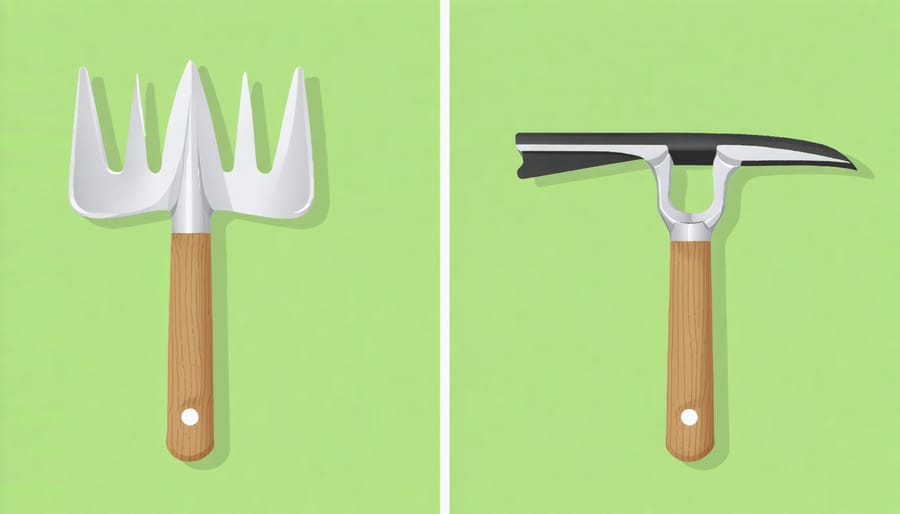
Multi-functional Tools
In today’s space-conscious world, multi-functional garden tools have become increasingly popular among landscapers and gardening enthusiasts. These clever innovations combine multiple tools into one, saving both storage space and money while delivering impressive versatility.
The Swiss Army knife of landscaping tools, the multi-tool handle system, typically features a universal handle that accepts various attachments. With one base unit, you can switch between a rake, hoe, cultivator, or even a pruning saw. This modular approach not only maximizes storage efficiency but also makes tool transport much easier.
Another standout in this category is the combination spade-hoe. One end functions as a traditional spade for digging and edging, while the other serves as a hoe for weeding and soil preparation. Similarly, the rake-hoe hybrid proves invaluable during fall cleanup, allowing you to both rake leaves and break up soil without switching tools.
For container gardening and small spaces, the 3-in-1 hand tool combines a trowel, cultivator, and weeder in a compact design. These tools often feature ergonomic handles and durable construction, ensuring they can handle multiple tasks while maintaining comfort and longevity.
When selecting multi-functional tools, look for those with sturdy construction and smooth mechanism changes. While they may cost more initially, their versatility and space-saving benefits make them a wise investment for any gardener’s toolkit.
Specialized Tools for Specific Tasks
Precision Pruning and Trimming
Precision pruning and trimming require specialized tools that can make the difference between a well-maintained landscape and an untidy one. Professional-grade pruning shears, with their sharp, bypass blades, are essential for clean cuts on live stems up to ¾ inch thick. For smaller, more delicate work, consider investing in topiary shears, which allow for intricate shaping of hedges and ornamental plants.
Long-handled loppers are your go-to tools for thicker branches, typically handling diameters up to 2 inches. Look for models with telescoping handles, which provide extra reach for tall shrubs while reducing strain on your back. For the highest branches, pole pruners combine the precision of pruning shears with extensions that can reach up to 12 feet or more.
Japanese pruning saws have become increasingly popular among gardening enthusiasts, and for good reason. Their pull-stroke cutting action and ultra-sharp teeth make clean cuts that promote faster healing in plants. For detailed work around delicate plants, pruning snips with their small, precise blades are invaluable.
Electric and battery-powered hedge trimmers have revolutionized the maintenance of formal hedges and topiaries. Modern versions come with adjustable heads and ergonomic handles, making it easier to achieve professional-looking results. Remember to keep all cutting tools sharp and clean, as dull blades can damage plants and potentially introduce diseases.
Efficient Soil Working Tools
Modern soil preparation has become significantly easier with innovative tools designed for efficiency and ergonomic comfort. The traditional spade and fork have evolved into more user-friendly options that reduce strain while delivering excellent results.
The broadfork, a long-handled tool with multiple tines, stands out as a game-changer for soil aeration. By stepping on its crossbar and using your body weight rather than just arm strength, you can effectively loosen soil without disturbing its natural structure. This makes it perfect for no-till gardening enthusiasts.
For precise soil working, the Japanese Hori Hori knife deserves special mention. This versatile tool combines the features of a trowel and knife, making it ideal for transplanting, dividing perennials, and removing stubborn weeds. Its measurements along the blade help ensure proper planting depths.
The wheel hoe represents another brilliant innovation, allowing gardeners to prepare soil and remove weeds while walking upright. This reduces back strain significantly and increases working speed. For smaller spaces, the oscillating stirrup hoe offers similar benefits with its back-and-forth motion that cuts weeds just below the soil surface.
Battery-powered tillers have also revolutionized soil preparation. These lightweight machines provide the power of traditional gas tillers without the noise, emissions, or maintenance hassles. They’re particularly useful for maintaining established beds and working in tight spaces.
To complement these tools, soil sifters and screens help create the perfect growing medium by removing stones and breaking up clumps, ensuring optimal conditions for plant growth.
Water Management Solutions
Modern water management tools have revolutionized how we maintain beautiful, sustainable landscapes while conserving our precious water resources. Smart irrigation controllers lead the pack, automatically adjusting watering schedules based on weather conditions and soil moisture levels. These clever devices can reduce water usage by up to 30% while keeping your garden thriving.
Drip irrigation systems have become a gardener’s best friend, delivering water directly to plant roots through a network of flexible tubes and emitters. This precise method minimizes water waste through evaporation and ensures each plant gets exactly what it needs. Pair these with moisture sensors, which monitor soil conditions and prevent overwatering, creating an efficient automated system.
Rain harvesting equipment, including rain barrels and collection systems, helps gardeners make the most of natural precipitation. These systems can store hundreds of gallons of water for use during dry spells, making them both eco-friendly and cost-effective.
For smaller gardens, water-efficient spray nozzles and adjustable sprinklers offer excellent control over water distribution. Many modern nozzles feature multiple spray patterns and flow controls, allowing you to customize watering for different plant types and garden zones.
Don’t forget about simple but effective tools like moisture meters and rain gauges. These affordable devices help you make informed decisions about when and how much to water, preventing both under and overwatering while maintaining optimal growing conditions.
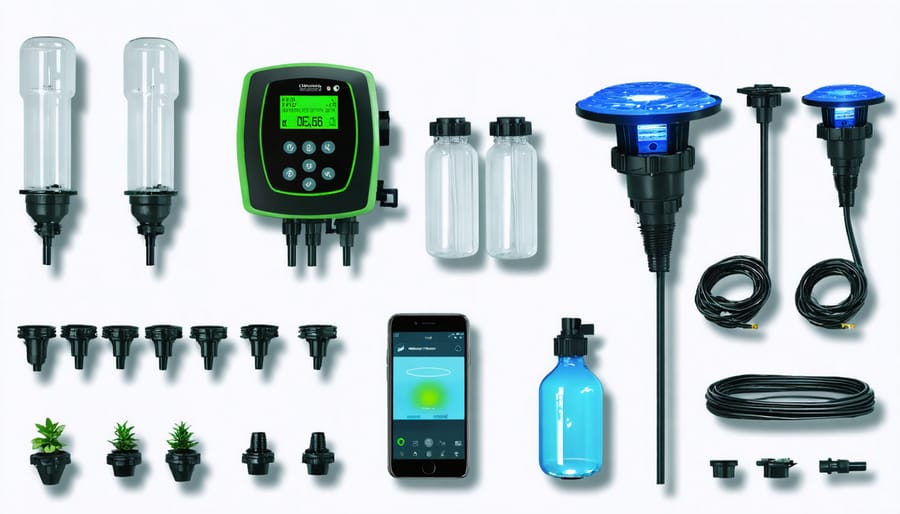
Maintenance and Care Tips
Proper maintenance of your landscaping tools isn’t just about keeping them looking nice – it’s essential for their performance and longevity. Learning how to maintain your gardening tools will save you money and ensure they’re ready when you need them.
After each use, clean your tools thoroughly to remove dirt, sap, and debris. A stiff brush works well for most tools, while a damp cloth can help with stubborn residue. For cutting tools like pruners and shears, use rubbing alcohol to sanitize the blades, preventing the spread of plant diseases.
Keep your tools dry to prevent rust. A light coating of mineral oil on metal parts provides excellent protection. For wooden handles, apply linseed oil occasionally to prevent splitting and extend their life. Store tools in a dry, covered area, preferably hanging on a wall or in a tool rack rather than piled in a corner.
For power equipment, regular maintenance is crucial. Change oil and air filters according to the manufacturer’s schedule, and always use fresh fuel. Keep blades sharp – dull blades not only perform poorly but can damage plants and strain engines. Consider having professional servicing done annually for complex power tools.
Remember to inspect tools regularly for loose handles, bent parts, or damage. Catching issues early prevents accidents and extends tool life significantly.
Modern landscaping tools have revolutionized the way we maintain and beautify our outdoor spaces. From ergonomic hand tools that reduce strain to efficient power equipment that saves time and energy, today’s options make gardening more accessible and enjoyable than ever before. By investing in quality tools and regularly maintaining them, you’ll not only achieve better results but also save money in the long run. Whether you’re a weekend gardener or a dedicated enthusiast, upgrading your toolkit with some of these innovative options will help you work smarter, not harder. Remember, the right tools make all the difference in creating and maintaining the landscape of your dreams. Take time to evaluate your needs, and don’t hesitate to embrace new technologies that can make your gardening journey more rewarding and sustainable.


